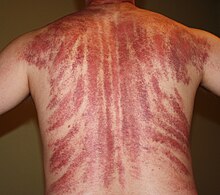This is an old revision of this page, as edited by 99.43.1.101 (talk) at 00:09, 19 June 2020. The present address (URL) is a permanent link to this revision, which may differ significantly from the current revision.
Revision as of 00:09, 19 June 2020 by 99.43.1.101 (talk)(diff) ← Previous revision | Latest revision (diff) | Newer revision → (diff)| Gua sha | |||||||||||||||||
|---|---|---|---|---|---|---|---|---|---|---|---|---|---|---|---|---|---|
 | |||||||||||||||||
| Chinese | 刮痧 | ||||||||||||||||
| Literal meaning | "scraping sha-bruises" | ||||||||||||||||
| |||||||||||||||||
Gua sha (Chinese: 刮痧), kerokan or coining is part of traditional Chinese medicine (TCM). Its practitioners use a tool to scrape people's skin to cause tissue damage in the belief this has medicinal benefit. Gua sha is sometimes referred to as "scraping", "spooning" or "coining" by English speakers. The treatment has also been called the descriptive French name, tribo-effleurage.
Effectiveness
As reported by a review article in the Journal of the American Academy of Dermatology, the negative side effects of gua sha range from minor ones – including dermatitis, burns and blood in the urine – to rare major ones including bleeding in the brain and severe injuries requiring skin grafts.
Etymology
Gua sha was transferred from China to Vietnam, where it became very popular. It is known as cạo gió, which roughly means "to scrape wind", as in Vietnamese culture "catching a cold" or fever is often referred to as trúng gió, "to catch wind". The origin of this term is the Shang Han Lun, a c. 220 CE Chinese medical text on illness caused by cold. As in most Asian countries, China's medical sciences were a profound influence in Vietnam, especially between the 5th and 7th centuries CE. Cạo gió is an extremely common remedy in Vietnam and for expatriate Vietnamese.
In popular culture
The 2001 movie The Gua Sha Treatment (Chinese: 刮痧; pinyin: guā shā) was made in Hong Kong and showed gua sha. It is a story about cultural conflicts experienced by a Chinese family in the United States.
See also
References
- ^ Vashi NA, Patzelt N, Wirya S, Maymone MB, Zancanaro P, Kundu RV (2018). "Dermatoses caused by cultural practices: Therapeutic cultural practices". J Am Acad Dermatol (Review). 79 (1): 1–16. doi:10.1016/j.jaad.2017.06.159. PMID 29908818.
- Huard & Wong (1977), p.126. Also cited is a French romanization for the same set of two Chinese characters: koua sha.
- Needham, J., Celestial Lancets, Cambridge, UK: Cambridge University.
- "EFL Movie Study Guide for: The Gua Sha Treatment". Krigline.com. Krigline. Archived from the original on 17 February 2019. Retrieved 17 February 2019.
- "The Treatment: User Reviews". IMDB.com. IMDB. Archived from the original on 17 February 2019. Retrieved 17 February 2019.
e
Categories: